| First
Things First: What Version Do You Have? |
| |
|
| Before we get started, let's
figure out what version of Netscape you're running. You should
know this information. |
| |
|
| |
To find your version of Netscape, click Help >> About
Communicator... on
the Netscape menu bar... |
| |
|
| |
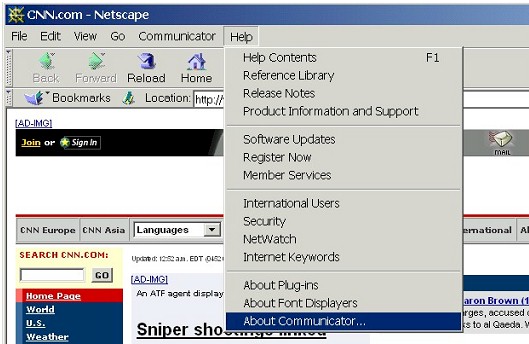 |
| |
|
| |
A web page should open up with version
information. |
| |
|
| |
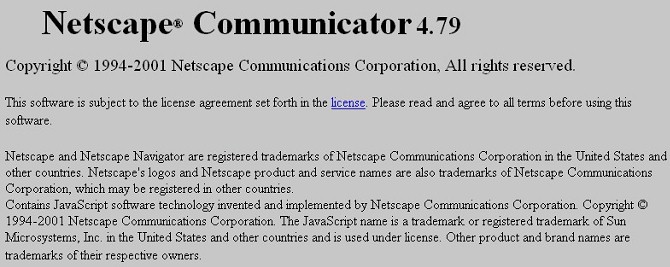 |
| |
|
| |
Right there is big bold letters is your version of Netscape -- Netscape
Communicator 4.79, in this case.
|
| |
|
| |
When you have the information you
need, click the back button to return to the web page you were on. |
| |
|
| Configuring Netscape's Privacy & Security Preferences |
| |
|
| Compared with Internet Explorer, Netscape's
privacy and security settings are simpler and easier to manage, though
they're more limited and less powerful. |
| |
|
| 1. |
Open the Netscape Preferences Box |
| |
|
| |
Open the Preferences box from w/in Netscape Navigator (Edit >> Preferences).
Netscape lets you access most of its configuration options here.
|
| |
|
| |
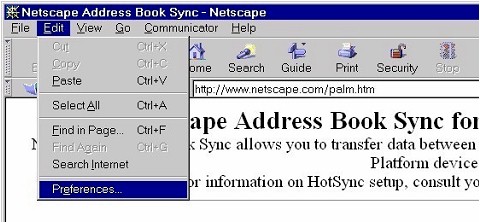 |
| |
|
| |
The first thing we'll do is clear the URL History
to protect the confidentiality of what we've done on the Net. For more
information on the privacy issues involved with the URL History
see THIS
page. |
| |
|
| 2. |
Clear History & Location Bar
|
| |
|
| |
When you open the Preferences dialog box from w/in the
Netscape browser (Navigator), you start on the Navigator menu option. We select categories from the tree menu on the left --
Netscape displays the corresponding options on the right. |
| |
|
| |
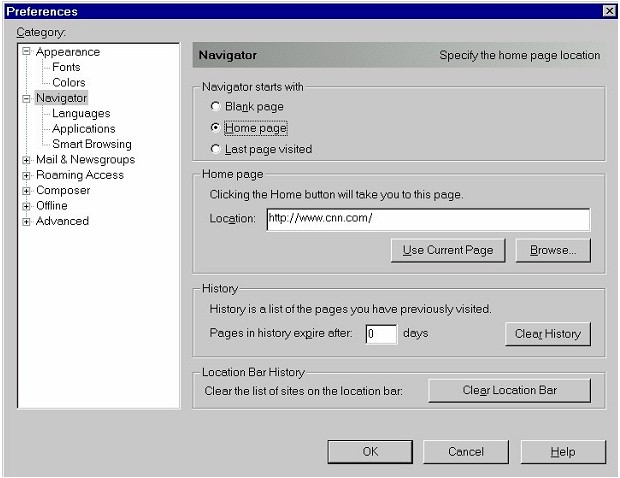 |
| |
|
| |
From this page we can clear the History, set the History to
be kept in
number of days, and clear the Location Bar (URL dropdown list). |
| |
|
| |
Note: The "Clear Location Bar" button first appeared in
Netscape 4.5. It does not appear in Netscape 4.0-4.08. In Netscape 4.0-4.08 there was no easily accessible way to clear the Location Bar. |
| |
|
| 3. |
Disable Java, JavaScript, &
Cookies |
| |
|
| |
Next we drop down on the tree menu to the Advanced sub-menu. The Advanced options
sub-menu gives us the Java and JavaScript settings. This menu also allows us to configure
the handling of Cookies.
|
| |
|
| |
Java & JavaScript |
| |
|
| |
We might want to consider disabling Java and JavaScript
-- the two forms of "active content" that Netscape
can use. (You
won't find ActiveX settings here because, unlike Internet Explorer,
Netscape can't run ActiveX controls.) For more information
on the privacy and security issues involved with "active content,"
see THIS
page. |
| |
|
| |
To disable Java and JavaScript, uncheck the
appropriate boxes on the Advanced sub-menu. |
| |
|
| |
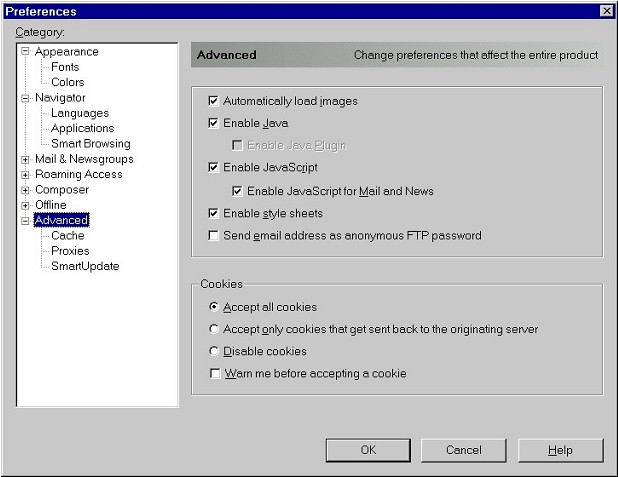 |
| |
|
| |
Note that with Java and JavaScript disabled,
some web sites might not work properly. In those cases, you can
re-enable Java and JavaScript on a site-by-site basis.
Even if you decide to keep JavaScript enabled (it is the most
commonly sued form of "active content" on the Net), you ought
to consider disabling it for Mail and News, as JavaScript
is used within emails and news messages almost exclusively for malicious
purposes. |
| |
|
| |
Cookies |
| |
|
| |
Cookies are small "data tags" that allow web
sites to recognize us when we return to those web sites. While cookies
can be useful -- say, for being recognized at a web site with which
we've registered -- they can also be used by advertisers to track our
movements and behavior across the Net. To protect our privacy, we need
to configure Netscape's cookie settings so that the browser
stores only cookies that we find useful. For more information on the
privacy issues involved with cookies, see THIS
page. |
| |
|
| |
Netscape Communicator gives us several options for dealing
with cookies:
- we can Accept all cookies
- we can Disable all cookies
- we can Accept only cookies that get sent back to the
originating server
If we disable Cookies, some web sites may not work properly. One
solution to this problem is to leave Cookies enabled, and
selectively manage and delete cookies by editing Netscape's Cookies.txt
file. For instructions on how to do so, see the next section on this page.
|
| |
|
| |
A still better choice is to select the "Accept only cookies that get sent back to the
originating server" setting, which allows us to filter out third-party
cookies that often used by advertisers and marketers (who place banner ads
on web sites), while keeping truly useful cookies from the web sites we
often visit.
|
| |
|
| |
Summing it all up
|
| |
|
| |
And here is the same Advanced options sub-menu as in the screenshot
just above, but with all the important options disabled. |
| |
|
| |
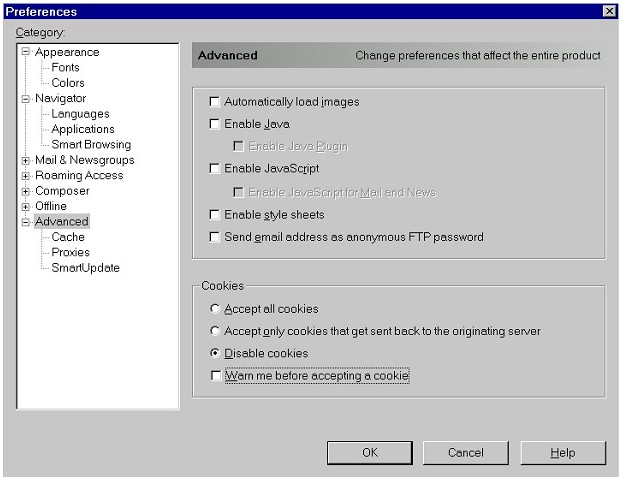 |
| |
|
| 4. |
Clear the Disk Cache |
| |
|
| |
The next thing we'll do is clear the Cache -- again
to protect the confidentiality of what we've done on the Net. For more
information on the privacy issues involved with the Cache see THIS
page. |
| |
|
| |
Still further down on the main menu is the Advanced
/ Cache sub-menu, which allows us to clear the Disk Cache and set the
Disk Cache size in KB. |
| |
|
| |
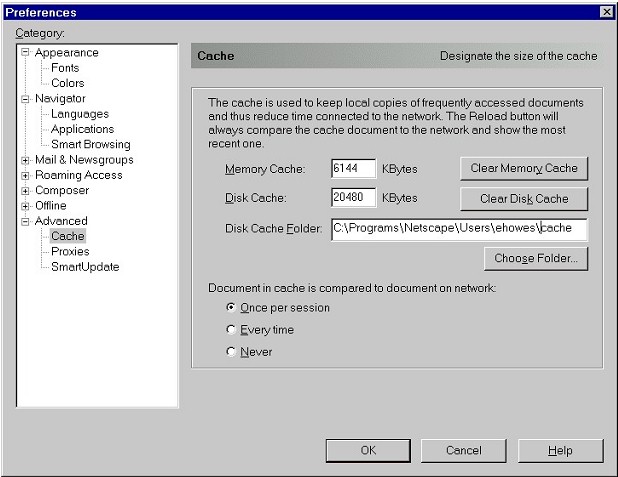
|
| |
|
| |
We can also clear and tweak the Memory Cache (which is similar to the Disk Cache, but kept in RAM).
Note that the
Disk Cache location on our hard drive is:
|
| |
|
| |
\Program Files\Netscape\Communicator\Users\<username>\Cache |
| |
|
| |
Browser cache files can be viewed and manually deleted from this location, just as they can be viewed and manually deleted in
Internet Explorer's \Windows\Temporary Internet
Files. |
| |
|
| Selectively Deleting & Managing Cookies |
| |
|
| If we prefer not to disable Cookies from the
Netscape Preferences menu (as we discussed above), we
can selectively manage and delete cookies by editing Netscape's
Cookies.txt file, in which Netscape stores all of our cookies. |
| |
|
| 1. |
Open Windows Explorer |
| |
|
| |
To access Netscape's Cookies.txt file, we need to open Windows
Explorer first.
|
| |
|
| |
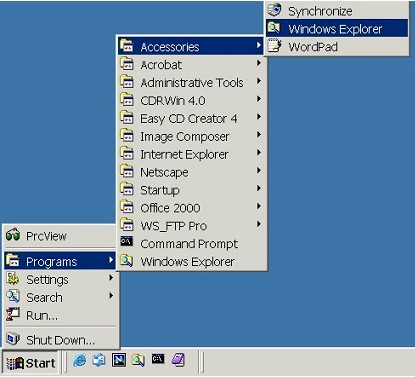
|
| |
|
| 2. |
Locate & Open Cookies.txt |
| |
|
| |
Once Windows Explorer is open, we can navigate to the Netscape
directory. Netscape stores all of its cookies in a single text file usually located here:
|
| |
|
| |
\Program Files\Netscape\Communicator\Users\<username>\cookies.txt |
| |
|
| |
Here is Cookies.txt in its standard location as viewed in
Windows Explorer. Note that the Netscape Disk Cache directory (
\CACHE ) is here as well. |
| |
|
| |
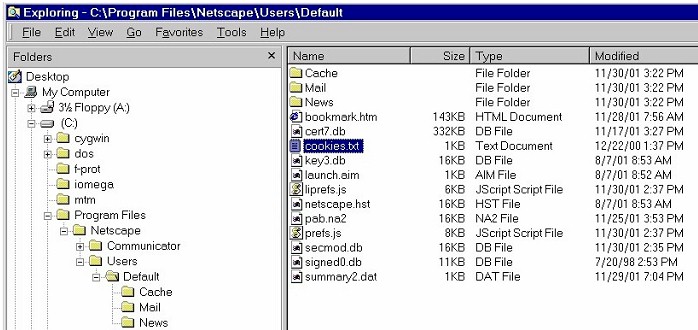 |
| |
|
| 3. |
Edit Cookies.txt |
| |
|
| |
Once we find Cookies.txt, we can open it by simply
double-clicking on the file. It will open in Notepad, a plain text
editor. Despite the warning at the top, this plain text file is editable. With
Word Wrap off in Notepad, we see one cookie per line. To remove a cookie, delete the corresponding line and then
save your changes (File >> Save). |
| |
|
| |
 |
| |
|
| |
The strange looking kcookie.netscape.com line is automatically
added by
Netscape to defend against a JavaScript exploit that allows third-parties to read cookies out of users'
Cookies.txt files. It should be preserved. |
| |
|
| |
One neat trick we can play with the Cookies.txt file is to
make the file "Read Only" and then enable Cookies on in the Preferences menu. Doing so allows
us to accept cookies from any site that might require them, but effectively turn them into
"session" cookies. "Session" cookies are temporary
cookies that disappear when
Netscape is closed and are not saved to disk. In effect, we force
"permanent" cookies to become "session" cookies because
cookies can't be written to Cookies.txt. Cookies that we want to preserve can still be accessed and used by sites that require
them, as long as we allow those cookies to be saved to Cookies.txt
before we make the file "Read Only." |
| |
|
| Note: All of the options presented
here are global, meaning that they apply to every web site visited. There
is nothing in Netscape Communicator comparable to the Security
zones used by Internet Explorer 4, 5, and 6, or the Privacy tab options seen
in Internet Explorer 6.
|
| |
|
| For example, if you disable JavaScript and
then encounter a web site that requires JavaScript to function,
your only option is to re-enable JavaScript. Once you re-enable
JavaScript, every web site that you visit will be able to
make use of JavaScript. |
| |
|
| Conclusion |
| |
|
| I hope you've found this short tour of Netscape Communicator's privacy and
security features interesting and helpful. If you need more assistance or
still have questions, check the following web pages for links to
information about web browser privacy and security: |
| |
|
| |
|









